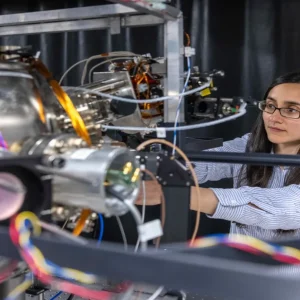
This is an amended version of the latest edition of Quantum Untangled, Tech Monitor’s weekly newsletter that delves into the practical implications of quantum computing. Subscribe here to get it delivered to your inbox every Thursday morning.
Though mainly concerned with the serious business of tinkering with the taxation burden shouldered by the great British public, the annual Autumn Statement never fails to provide something for Tech Monitor to cover. This year, that came in the form of a new slab of cash for AI research and reforms designed to spur traditionally skittish UK pension funds into investing more in British tech businesses and spin-out companies, measures that the author of this newsletter first encountered during his research into the opposition Labour Party’s tech policies.
We were also promised a quantum announcement. Chancellor Jeremy Hunt, eager to burnish the tech credentials of an incumbent government with a double-digit polling deficit, was supposed to announce what The Telegraph dubbed a series of quantum “computing moonshots” worth hundreds of millions of pounds. There were even plans, the broadsheet intimated, for a national quantum supercomputer, alongside other investments in “quantum clocks, sensors, imaging and financial trading systems.”

The Autumn Statement’s quantum priorities
Nary a peep of this scheme made its way into Hunt’s speech to the House of Commons on Wednesday. But what did emerge, deep within the annual document dump that accompanies every year’s Autumn Statement, was an update to the government’s National Quantum Strategy outlining the government’s long-term quantum goals. Since the publication of that document in March, it added, ministers and civil servants have “worked with industry, quantum experts, and investors to develop missions that will bring significant benefits to the economy and society.”
These missions are not modest. “By 2035,” writes the government, “there will be accessible, UK-based quantum computers capable of running 1 trillion operations and supporting applications.” That same year, the country will also apparently be running “the world’s most advanced quantum network,” with the National Health Service already benefiting from quantum sensing applications to allow “those with chronic illness [to] live healthier, longer lives.” Meanwhile, quantum navigation systems will be found on most aircraft, precluding the need for antiquated satellite navigation, while other such sensor networks “will have unlocked new situational awareness capabilities” in the telecoms, energy and defence sectors.
The document then explains how all these targets might be achieved, with the kind of certainty around timelines that quantum researchers usually disdain (though its single footnote explains that “timing expectations will be further defined as the mission programme progresses.”) Some points come across as more akin to aspirational goals rather solid statements of intent. Achieving its goal of deploying a quantum internet, for example, will see the UK work “with at least five other countries to collaborate on developing underpinning technologies,” though these nations go unnamed. Getting to the point where the UK is running a trillion-operations quantum computer will also, the government writes, require “competitive UK-based commercial capabilities across hardware, control architecture and the supply chain,” without clarifying whether that will be accompanied by a quantum-specific industrial strategy.
Other measures seem more realistic. The claim that, by 2028, “quantum-enabled brain scanners” will be used to facilitate surgery for children with severe neurological diseases, for example, is grounded in promising new research, as is the ambition to connect multiple cities in a quantum network.
Indeed, the long-term missions were welcomed by many in the British tech sector, starting with its premier industry association. “techUK welcomes the announcement of the Quantum Missions as a crucial milestone in the delivery of the National Quantum Strategy,” its head of tech and innovation, Laura Foster, told this newsletter. “There are still questions on how these missions will be developed and deployed, but techUK looks forward to working with the Office for Quantum on understanding how these missions will help grow a thriving quantum industry in the UK.” IQM Quantum Computers’ Dr. Jan Goetz was even more supportive. “Today, the UK has announced that it is investing heavily into quantum technology,” said Goetz. “This signifies that the country leaders have understood the potential benefits of quantum and are acting to take advantage of the efficiencies it will provide.”
Where’s quantum encryption in all this?
Others, however, were concerned that one sub-sector had been completely omitted from the Autumn Statement’s quantum goals: quantum encryption. “What is not being recognised is that quantum computers will not be superior to classical computers in every area — classical machines will continue to be used for the majority of tasks we undertake today,” said Andersen Cheng, co-founder of Post-Quantum and one of the first to popularise the concept of harvest now, decrypt later (HNDL) attacks. “However, quantum computers are vastly superior when performing big analysis on small amounts of data — precisely the quality needed to break the encryption used to secure the UK’s entire digital infrastructure.
“Allies like the US have realised this, introducing a swathe of legislation to prompt both the public and private sectors to begin migrating to PQC that is widely regarded as our best opportunity, and indeed our only chance, to secure infrastructure at scale. While the UK has produced guidance in this area, there is a comparative lack of urgency when it comes to shielding against the threats these machines pose.”
Not everyone agrees that HNDL attacks from quantum computers are in the offing, much less happening now — see cryptography expert Professor Ross Anderson’s recent contribution to this newsletter that the danger of such breaches had been “overhyped.” The UK government, too, has hardly been silent on the issue, mentioning it in its March strategy document (see p.44) and the National Cyber Security Centre recently revised its advice to organisations looking to transition to post-quantum cryptography. Still, the fact that it has chosen not to anchor any of its long-term quantum missions in this research area is striking, to say the least. Whether this omission is innocent or a subtle indication of how seriously Whitehall is greeting the threat of HNDL attacks remains to be seen.






